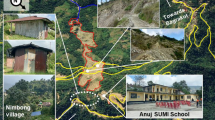Abstract
A practical application of a simple and economical solution to landslide hazard zonation based on slope stability analysis was carried out in the Veľká Čausa landslide, Horná Nitra region, central Slovakia. The region is prone to different types of slope deformation controlled by geological structure, physical and mechanical properties of materials, complicated hydrogeological setting, undulating morphology, and man-made influence. Taking into consideration the cause of the landslide, identified as groundwater change, two scenarios of landslide activity have been investigated. Scenario 1 considers the maximum groundwater level recorded from March 1995 to October 1998, corresponding to the period starting from the most recent landslide activity up to the end of remediation work. Scenario 2 considers the maximum groundwater level recorded from November 1998 to December 2004, after the remediation works, and corresponding to the actual situation of the landslide. It has been found from this study that slope angle has the highest influence on landslide instability in the Veľká Čausa landslide. Therefore, high resolution Digital Elevation Model (DEM) is essential for obtaining reasonable results. In addition, an appropriate selection of the model input parameters (e.g., shear strength) is very important. The validation between the calculated landslide hazard zonation map and results of monitoring survey were examined. The results show moderate to good agreement with the inclinometric and geodetic measurements. It was also verified that the most active part of the landslide is the north-western side.










Similar content being viewed by others
Abbreviations
- DEM:
-
Digital Elevation Model
- GIS:
-
Geographical Information Systems
- SINMAP:
-
Stability Index Mapping
- TRIGRS:
-
Transient Rainfall Infiltration and Grid-based Regional Slope-stability analysis
References
Aleotti P, Chowdhury R (1999) Landslide hazard assessment: summary review and new perspectives.. Bull Eng Geol Environ 58(1):21–44
Atlas SSR (1980) Set of 866 maps (scale 1:500 000), SAV and SUGK, Text part (1982) Veda Bratislava, 161 p
Baum RL, Coe JA, Godt JW, Harp EL, Reid ME, Savage WZ, Schulz WH, Brien DL, Chleborad AF, McKenna JP, Michael JA (2005) Regional landslide-hazard assessment for Seattle, Washington, USA. Landslides 2(2):266–279
Chowdhury R, Flentje P (2003) Role of slope reliability analysis in landslide risk management.. Bull Eng Geol Environ 62(1):41–46
Corominas J, Santacana N (2003) Stability analysis of the Vallcebre translational slide, Eastern Pyrenees (Spain) by means of a GIS.. Nat Hazards (Dordr) 30(3):473–485
Graham J (1984) Methods of stability analysis. In: Brunsden D, Prior DB (eds) Slope instability. Wiley, Chichester, pp 171–215
Jadroň D, Mokrá M (1999) Active landslides in the regions of Horná Nitra and Stredné Považie. Manuscript, INGEO Žilina, 31 p (In Slovak)
Jadroň D, Mokrá M, Wagner P (2000) Practical application of monitoring results of an active landslide. In: Proceedings of 8th Conference on landslides. Cardiff, Thomas Telford, London, pp 763–768
Jadroň D, Mokrá M, Wagner P, Fussgänger E (2001) Stabilisation of the active landslide in Veľká Čausa. In: Proceedings of the Conference: geology and the environment 2, ŠGÚDŠ Bratislava, pp 29–33 (in Slovak)
Klukanová A, Liščák P (2004) National environmental monitoring of the Slovak Republic – part geological hazards. In: Hack R, Azzam R, Charlier R (eds) Engineering geology for infrastructure planning in Europe. Springer, Berlin Heidelberg New York, pp 650–656
Krcho J (1973) Morphometric analysis of relief on the basis of geometric aspect of field theory.. Acta Geogr UC Geogr Physica 1:11–233
Krcho J (1990) Morphometric analysis and digital models of geo-relief. VEDA, Bratislava, Slovakia, p 426In Slovak)
Mesko M, Otepka J, Menzelová O, Novotný P, Štofko S (1985) Veľká Čausa—the investigation and the stabilization works. Manuscript, SGÚ Bratislava, p 40, (In Slovak)
Mitášová H, Hofierka J (1993) Interpolation by regularized spline with tension: II. Application to terrain modeling and surface geometry analysis. Math Geol 25:657–669
Montgomery DR, Dietrich WE (1994) A physically-based model for topographic control on shallow landsliding. Water Resour Res 30(4):1153–1171
Moon V, Blackstock H (2003) A methodology for assessing landslide hazard using deterministic stability models. Nat Hazards 32:111–134
Nash D (1987) A comparative review of limit equilibrium methods of stability analysis. In: Anderson MG, Richards KS (eds) Slope stability: geotechnical engineering and geomorphology. Wiley, New York, pp 11–75
Otepka J, Tichý Š, Roháčiková A, Fekeč J, Obernauer M (1976) Veľká Čausa—the investigation and the evaluation of landslides. SGÚ Bratislava, p 79 (In Slovak)
Pack RT, Tarboton DG, Goodwin CN (1998) The SINMAP approach to terrain stability mapping. In: Moore DP, Hungr O (eds) 8th Congress of the International Association of Engineering Geology, Vancouver, British Columbia, 21–25 September 19981157–1165
Salciarini D, Godt JW, Savage WZ, Conversini P, Baum RL, Michael JA (2006) Modeling regional initiation of rainfall-induced shallow landslides in the eastern Umbria Region of central Italy. Landslides 3(3):181–194
Shuzui H (2001) Process of slip-surface development and formation of slip-surface clay in landslides tertiary volcanic rocks, Japan. Eng Geol 61(4):199–219
Terlien MTJ, van Ash ThWJ, van Westen CJ (1995) Deterministic modelling in GIS-based landslide hazard assessment. In: Carrara A, Guzzetti F (eds) Geographical information systems in assessing natural hazards. Kluwer, Dordrecht, pp 55–57
van Westen CJ (1993) GISSIZ. Training package for geograophic infromation systems in slope instability zonation. Part 1: theory. UNESCO—ITC Project on “Geo-information for environmentally sound management of natural resources”. Enschede, Netherlands
van Westen CJ, Terlien MTJ (1996) An approach towards deterministic landslide hazard analysis in GIS. A case study from Manizales (Colombia). Earth Surf Processes Landf 21(9):853–868
Wagner P, Scherer S, Jadroň D, Mokrá M, Vybíral V (2002) Analysis of landslide monitoring results. In: Proceed of the first European Conference on Landslides, Prague, A.A. Balkema, Lisse, Abingdon, Exton, Tokyo, pp 471–476
Zaitchik BF, van Es HM, Sullivan PJ (2003) Modeling slope stability in Honduras: parameter sensitivity and scale of aggregation. Soil Sci Soc Am J 67(1):268–278
Záruba Q, Mencl V (1969) Landslides and their control.. Elsevier, Amsterdam (in coedition with Academia, Prague)
Author information
Authors and Affiliations
Corresponding author
Rights and permissions
About this article
Cite this article
Jelínek, R., Wagner, P. Landslide hazard zonation by deterministic analysis (Veľká Čausa landslide area, Slovakia). Landslides 4, 339–350 (2007). https://doi.org/10.1007/s10346-007-0089-9
Received:
Accepted:
Published:
Issue Date:
DOI: https://doi.org/10.1007/s10346-007-0089-9




